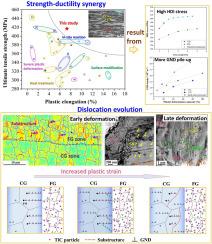当前位置:
X-MOL 学术
›
J. Magnes. Alloys
›
论文详情
Our official English website, www.x-mol.net, welcomes your
feedback! (Note: you will need to create a separate account there.)
Revealing Hetero-Deformation Induced (HDI) Hardening and Dislocation Activity in a Dual-Heterostructure Magnesium Matrix Composite
Journal of Magnesium and Alloys ( IF 15.8 ) Pub Date : 2024-11-12 , DOI: 10.1016/j.jma.2024.10.012 Lingling Fan, Ran Ni, Lingbao Ren, Peng Xiao, Ying Zeng, Dongdi Yin, Hajo Dieringa, Yuanding Huang, Gaofeng Quan, Wei Feng
Journal of Magnesium and Alloys ( IF 15.8 ) Pub Date : 2024-11-12 , DOI: 10.1016/j.jma.2024.10.012 Lingling Fan, Ran Ni, Lingbao Ren, Peng Xiao, Ying Zeng, Dongdi Yin, Hajo Dieringa, Yuanding Huang, Gaofeng Quan, Wei Feng

|
Integrating a heterogeneous structure can significantly enhance the strength-ductility synergy of composites. However, the relationship between hetero-deformation induced (HDI) strain hardening and dislocation activity caused by heterogeneous structures in the magnesium matrix composite remains unclear. In this study, a dual-heterogeneous TiC/AZ61 composite exhibits significantly improved plastic elongation (PEL) by nearly one time compared to uniform FG composite, meanwhile maintaining a high strength (UTS: 417 MPa). This is because more severe deformation inhomogeneity in heterogeneous structure leads to more geometrically necessary dislocations (GNDs) accumulation and stronger HDI stress, resulting in higher HDI hardening compared to FG and CG composites. During the early stage of plastic deformation, the pile-up types of GND in the FG zone and CG zone are significantly different. GNDs tend to form substructures in the FG zone instead of the CG zone. They only accumulate at grain boundaries of the CG region, thereby leading to obviously increased back stress in the CG region. In the late deformation stage, the elevated HDI stress activates the new 〈c + a〉 dislocations in the CG region, resulting in dislocation entanglements and even the formation of substructures, further driving the high hardening in the heterogeneous composite. However, For CG composite, 〈c + a〉 dislocations are not activated even under large plastic strains, and only 〈a〉 dislocations pile up at grain boundaries and twin boundaries. Our work provides an in-depth understanding of dislocation variation and HDI hardening in heterogeneous magnesium-based composites.
中文翻译:

揭示双异质结构镁基复合材料中的异质变形诱导 (HDI) 硬化和位错活性
集成异质结构可以显著提高复合材料的强度-延展性协同作用。然而,镁基复合材料中异质变形诱导 (HDI) 应变硬化与异质结构引起的位错活性之间的关系尚不清楚。在本研究中,与均匀的 FG 复合材料相比,双异质 TiC/AZ61 复合材料的塑性伸长率 (PEL) 显著提高了近一倍,同时保持了高强度 (UTS: 417 MPa)。这是因为异质结构中更严重的变形不均匀性会导致更多的几何必要位错 (GND) 积累和更强的 HDI 应力,从而导致与 FG 和 CG 复合材料相比更高的 HDI 硬化。在塑性变形初期,FG 区和 CG 区 GND 的堆积类型存在显著差异。GND 倾向于在 FG 区而不是 CG 区形成子结构。它们仅在 CG 区域的晶界处积累,从而导致 CG 区域的背应力明显增加。在变形后期,升高的 HDI 应力激活了 CG 区新的 〈c + a〉 位错,导致位错缠结甚至形成子结构,进一步推动了非均质复合材料的高硬化。然而,对于 CG 复合材料,即使在大塑性应变下,〈c + a〉位错也不会被激活,只有 〈a〉位错堆积在晶界和孪晶界处。我们的工作为异质镁基复合材料中的位错变化和 HDI 硬化提供了深入的了解。
更新日期:2024-11-13
中文翻译:

揭示双异质结构镁基复合材料中的异质变形诱导 (HDI) 硬化和位错活性
集成异质结构可以显著提高复合材料的强度-延展性协同作用。然而,镁基复合材料中异质变形诱导 (HDI) 应变硬化与异质结构引起的位错活性之间的关系尚不清楚。在本研究中,与均匀的 FG 复合材料相比,双异质 TiC/AZ61 复合材料的塑性伸长率 (PEL) 显著提高了近一倍,同时保持了高强度 (UTS: 417 MPa)。这是因为异质结构中更严重的变形不均匀性会导致更多的几何必要位错 (GND) 积累和更强的 HDI 应力,从而导致与 FG 和 CG 复合材料相比更高的 HDI 硬化。在塑性变形初期,FG 区和 CG 区 GND 的堆积类型存在显著差异。GND 倾向于在 FG 区而不是 CG 区形成子结构。它们仅在 CG 区域的晶界处积累,从而导致 CG 区域的背应力明显增加。在变形后期,升高的 HDI 应力激活了 CG 区新的 〈c + a〉 位错,导致位错缠结甚至形成子结构,进一步推动了非均质复合材料的高硬化。然而,对于 CG 复合材料,即使在大塑性应变下,〈c + a〉位错也不会被激活,只有 〈a〉位错堆积在晶界和孪晶界处。我们的工作为异质镁基复合材料中的位错变化和 HDI 硬化提供了深入的了解。


















































 京公网安备 11010802027423号
京公网安备 11010802027423号